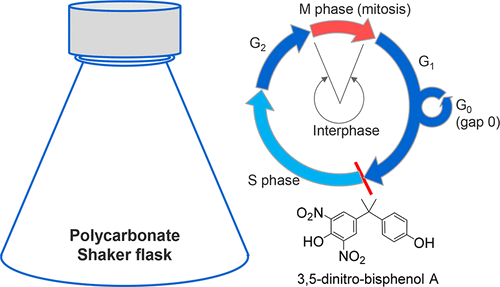当前位置:
X-MOL 学术
›
Anal. Chem.
›
论文详情
Our official English website, www.x-mol.net, welcomes your
feedback! (Note: you will need to create a separate account there.)
Chemical Identity and Mechanism of Action and Formation of a Cell Growth Inhibitory Compound from Polycarbonate Flasks
Analytical Chemistry ( IF 6.7 ) Pub Date : 2018-03-08 00:00:00 , DOI: 10.1021/acs.analchem.7b05102 Jinlin Peng , Yaopeng Zhao 1 , Yulong Hong , Robert S. Burkhalter , Carrie L. Hogue , Elizabeth Tran , Lai Wei 1 , Lori Romeo , Paula Dolley-Sonneville , Zara Melkoumian , Xinmiao Liang 1 , Ye Fang
Analytical Chemistry ( IF 6.7 ) Pub Date : 2018-03-08 00:00:00 , DOI: 10.1021/acs.analchem.7b05102 Jinlin Peng , Yaopeng Zhao 1 , Yulong Hong , Robert S. Burkhalter , Carrie L. Hogue , Elizabeth Tran , Lai Wei 1 , Lori Romeo , Paula Dolley-Sonneville , Zara Melkoumian , Xinmiao Liang 1 , Ye Fang
Affiliation

|
This paper reports the chemical identity and mechanism of action and formation of a cell growth inhibitory compound leached from some single-use Erlenmeyer polycarbonate shaker flasks under routine cell culture conditions. Single-use cell culture vessels have been increasingly used for the production of biopharmaceuticals; however, they often suffer from issues associated with leachables that may interfere with cell growth and protein stability. Here, high-performance liquid-chromatography preparations and cell proliferation assays led to identification of a compound from the water extracts of some polycarbonate flasks, which exhibited subline- and seeding density-dependent growth inhibition of CHO cells in suspension culture. Mass spectroscopy, nuclear magnetic resonance spectroscopy, and chemical synthesis confirmed that this compound is 3,5-dinitro-bisphenol A. Cell cycle analysis suggests that 3,5-dinitro-bisphenol A arrests CHO-S cells at the G1/Go phase. Dynamic mass redistribution assays showed that 3,5-dinitro-bisphenol A is a weak GPR35 agonist. Analysis of the flask manufacturing process suggests that 3,5-dinitro-bisphenol A is formed via the combination of molding process with γ-sterilization. This is the first report of a cell culture/assay interfering leachable compound that is formed through γ-irradiation-mediated nitric oxide free radical reaction.
中文翻译:

化学特性,作用机理和聚碳酸酯烧瓶中细胞生长抑制性化合物的形成
本文报道了在常规细胞培养条件下从一些一次性使用的Erlenmeyer聚碳酸酯摇瓶中浸出的细胞生长抑制性化合物的化学特性,作用机理和形成。一次性使用的细胞培养容器已越来越多地用于生产生物药物。然而,它们经常遭受与可浸出物有关的问题,这些可浸出物可能会干扰细胞生长和蛋白质稳定性。在这里,高效液相色谱准备工作和细胞增殖测定法从一些聚碳酸酯烧瓶的水提取物中鉴定出一种化合物,该化合物在悬浮培养中表现出对亚细胞和种子密度依赖性的CHO细胞生长抑制作用。质谱,核磁共振波谱和化学合成证实该化合物为3,1 / G o相。动态质量再分布测定表明3,5-二硝基双酚A是弱的GPR35激动剂。对烧瓶制造过程的分析表明,通过模制过程与γ灭菌相结合形成了3,5-二硝基双酚A。这是通过γ射线辐射介导的一氧化氮自由基反应形成的可干扰细胞培养/测定的可浸出化合物的首次报道。
更新日期:2018-03-08
中文翻译:

化学特性,作用机理和聚碳酸酯烧瓶中细胞生长抑制性化合物的形成
本文报道了在常规细胞培养条件下从一些一次性使用的Erlenmeyer聚碳酸酯摇瓶中浸出的细胞生长抑制性化合物的化学特性,作用机理和形成。一次性使用的细胞培养容器已越来越多地用于生产生物药物。然而,它们经常遭受与可浸出物有关的问题,这些可浸出物可能会干扰细胞生长和蛋白质稳定性。在这里,高效液相色谱准备工作和细胞增殖测定法从一些聚碳酸酯烧瓶的水提取物中鉴定出一种化合物,该化合物在悬浮培养中表现出对亚细胞和种子密度依赖性的CHO细胞生长抑制作用。质谱,核磁共振波谱和化学合成证实该化合物为3,1 / G o相。动态质量再分布测定表明3,5-二硝基双酚A是弱的GPR35激动剂。对烧瓶制造过程的分析表明,通过模制过程与γ灭菌相结合形成了3,5-二硝基双酚A。这是通过γ射线辐射介导的一氧化氮自由基反应形成的可干扰细胞培养/测定的可浸出化合物的首次报道。











































 京公网安备 11010802027423号
京公网安备 11010802027423号